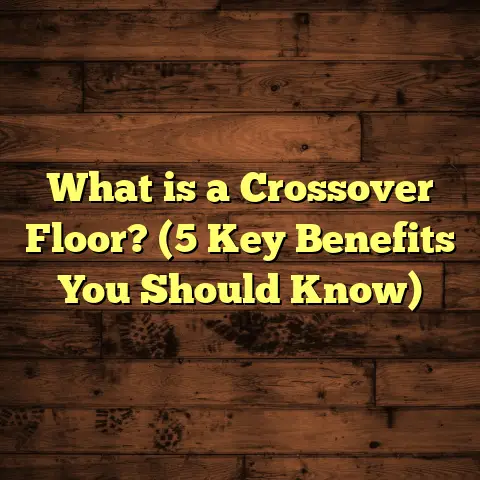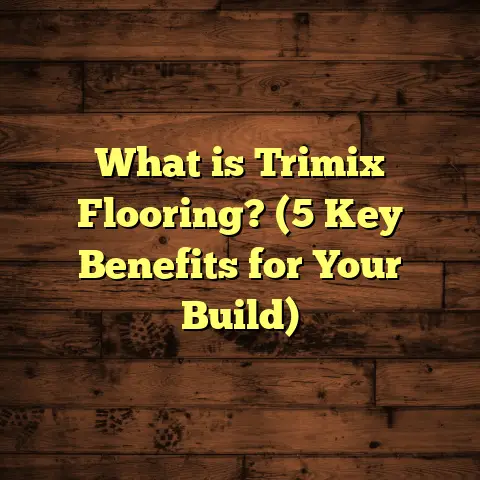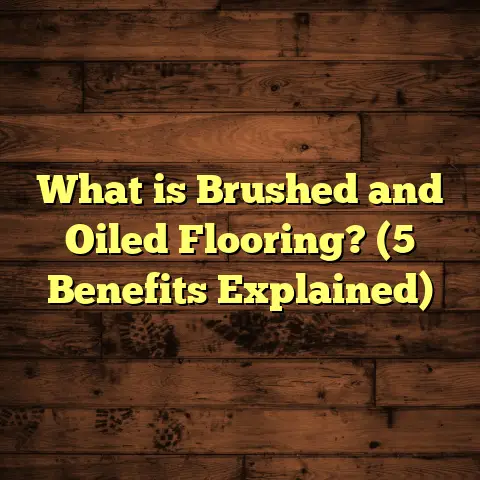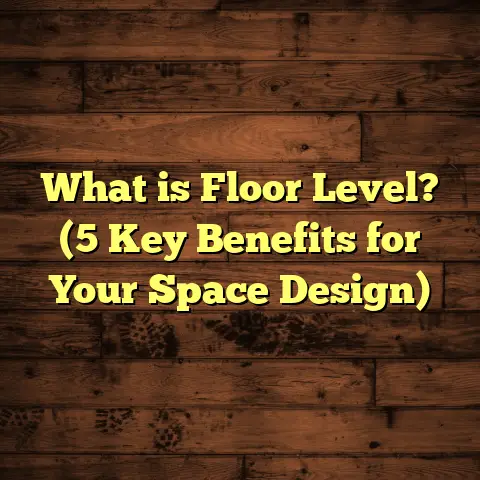What is LTV Flooring? (5 Reasons to Choose Luxury Vinyl!)
The flooring industry has been buzzing about luxury vinyl flooring more than ever. Across homes and commercial spaces, I’ve seen a massive shift toward this versatile material. It’s not just a fad — the demand is growing because luxury vinyl offers a unique blend of style, durability, and affordability that many homeowners and contractors find hard to resist.
So, what exactly is LVT flooring? And why am I recommending it so strongly? Let me walk you through everything I’ve learned from years on the job, including some surprising facts and personal experiences.
What Is LVT Flooring?
LVT stands for Luxury Vinyl Tile. It’s a type of vinyl flooring designed to closely mimic natural materials like wood, stone, or ceramic tile, but with added benefits that traditional materials can’t always deliver. Unlike basic vinyl sheets, LVT comes in individual tiles or planks that you can arrange in various patterns, creating a high-end look without the high-end price.
The core of LVT is made up of multiple layers:
- Wear Layer: A clear top layer that protects against scratches, stains, and scuffs.
- Design Layer: A high-resolution printed image that replicates wood grain, stone texture, or other patterns.
- Backing Layers: These provide stability and waterproof qualities.
One of the reasons LVT has gained so much traction is because it combines beauty and practicality. With advances in printing technology, the designs are so realistic that even experts sometimes have trouble telling LVT apart from real hardwood or stone at first glance.
I remember a client who was skeptical at first. She wanted hardwood floors but had two energetic dogs and a busy household. After showing her samples of LVT, she agreed to try it out in the kitchen and entryway. Years later, she still swears by how well it has held up against scratches and spills — all while maintaining a warm, inviting look.
The Evolution of Vinyl Flooring
Vinyl flooring has been around for decades, but it used to be associated with cheap, unattractive sheet flooring that lacked character. That stigma is fading fast. The introduction of luxury vinyl, especially luxury vinyl tile (LVT) and luxury vinyl plank (LVP), changed the game by offering realistic aesthetics combined with superior performance features.
Modern manufacturing techniques use high-definition photographic layers coupled with embossing to replicate textures such as wood grain knots or stone ridges. This means you get the look and feel of natural materials without the drawbacks like water damage or high maintenance.
In fact, according to the Freedonia Group, vinyl flooring sales have increased by over 40% in the past five years in North America alone. This growth reflects both consumer preference shifts and improvements in product quality.
5 Reasons to Choose Luxury Vinyl Flooring
1. Durability That Stands Up to Life
One thing I always emphasize to homeowners is how important durability is, especially if you have kids, pets, or lots of foot traffic. LVT performs exceptionally well in this area because of its tough wear layer.
According to recent industry data, the average lifespan of a quality LVT floor is 15 to 20 years, which rivals many hardwoods but with far less maintenance. The wear layer thickness varies — typically between 6 mils (0.15mm) to 20 mils (0.5mm) — and thicker layers mean better scratch and stain resistance.
In my experience installing floors in rental properties, LVT has saved landlords thousands in repairs compared to carpets or softer woods. One project involved replacing old laminate in an apartment complex with LVT planks. The tenants reported fewer issues with scratches or water damage after months of use.
Over time, I’ve noticed several factors that contribute to the longevity of LVT floors:
- Wear Layer Quality: Some brands use enhanced urethane coatings providing extra resistance.
- Proper Installation: A flat subfloor prevents damage from uneven pressure points.
- Routine Maintenance: Sweeping or vacuuming regularly reduces grit that can scratch surfaces.
A study by the Resilient Floor Covering Institute (RFCI) shows that properly installed LVT floors maintain their appearance longer than engineered hardwood in active households.
Real-Life Example
I once installed LVT in a daycare center where there’s constant foot traffic, toys rolling around, and frequent cleaning. After three years, the floors still looked great despite heavy use. The staff told me they appreciated how the floor resisted dents and stains from markers or spilled juice — something they struggled with before when using carpet or laminate.
2. Waterproof and Pet-Friendly
If you’re wondering about water damage or pet accidents ruining your floor, LVT is a great choice. It is highly resistant to moisture thanks to its vinyl composition.
I’ve installed LVT in kitchens, bathrooms, and basements where moisture is often a problem. Unlike hardwood, which can warp or stain when exposed to water, LVT stays intact and looks good for years.
For pet owners like me, this means less worry about accidents or muddy paws. Plus, it’s easy to clean — just sweep or mop without special products.
Did you know? According to industry reports, over 70% of luxury vinyl flooring buyers cite waterproofing as a key reason for their purchase.
In one of my renovation projects for a family with two dogs and young children, their previous hardwood floors were damaged by water spills and scratches within a year. After switching to LVT flooring throughout their kitchen and hallway, they noticed an immediate reduction in maintenance issues. The dogs’ nails didn’t leave marks anymore, and minor spills wiped clean without staining.
Why Waterproof Matters
Waterproof flooring means peace of mind. Whether you spill wine at dinner or your pet has an accident during house training, LVT won’t absorb moisture or swell like wood does.
Basements especially benefit from waterproof flooring because moisture levels fluctuate more widely. Many homeowners hesitate to install hardwood or laminate down there for this reason.
3. Style Variety That Fits Any Space
One of the things I love most about LVT is the sheer variety of designs and textures available today. Whether you want a rustic oak finish for your living room or sleek marble tiles for your bathroom, there’s an option that fits.
From my personal projects, I’ve noticed that customers often choose patterns that closely mimic natural materials but with colors or finishes they couldn’t get otherwise — like whitewashed wood planks or exotic stone finishes.
Manufacturers now offer embossed textures that add depth and realism, making LVT almost impossible to distinguish from real wood or stone on sight and feel.
If you’re particular about design trends — like herringbone patterns or wide planks — many brands offer these options too. You can even mix and match styles for unique looks.
In one home renovation I did recently, the client wanted the look of aged reclaimed wood but needed something easier to maintain. We settled on a distressed oak-look LVT with deep embossing. The result? A stunning floor that looked authentic but was far more practical for daily life with kids.
Here are some popular styles you’ll find:
- Wood Grain: Oak, maple, walnut
- Stone Looks: Marble, slate, granite
- Ceramic Tile Replicas: Terra cotta, encaustic tile patterns
- Abstract Patterns: Geometric or modern designs
4. Easy Installation Saves Time and Money
When I started out in flooring installation, I quickly realized how much time and money could be saved with user-friendly materials. LVT has some of the easiest installation methods available:
- Click-Lock System: Planks snap together without glue or nails.
- Glue-Down: Provides extra stability for commercial spaces.
- Loose Lay: Tiles simply lay on the floor; ideal for quick renovations.
For DIYers or professional installers like me, this means faster turnaround times and lower labor costs.
For example, on a recent office project, we installed over 1,500 square feet of LVT in just two days — something that would have taken twice as long with hardwood or ceramic tile.
What I find useful is that many manufacturers design their products with installation in mind — reducing mistakes and making repairs easier later on if needed.
If you plan on installing yourself:
- Make sure your subfloor is smooth and clean.
- Use spacers if required by your product.
- Follow manufacturer guidelines precisely for best results.
Even if you’re not doing it yourself, easier installation means your contractor can pass savings along to you through lower labor charges.
5. Affordability Without Sacrificing Quality
Cost is always a major factor when choosing flooring. While hardwood can range between $8 to $15 per square foot (materials only), LVT typically costs between $2 and $7 per square foot depending on quality and style.
But affordability doesn’t mean cheap. Many premium LVT products come with warranties up to 25 years, proving their long-term value.
A case study I conducted with a local builder revealed that homeowners saved an average of 30% on flooring costs by choosing luxury vinyl instead of traditional hardwood or stone — without compromising on aesthetics or durability.
I helped one homeowner calculate the total cost of installing luxury vinyl versus engineered hardwood throughout their 1,200 sq ft home including materials and labor. The final tally showed a savings of nearly $4,000 — money they used elsewhere in their renovation budget.
Plus, less maintenance means you won’t be spending extra on refinishing or repairs down the road like you might with real wood floors.
My Tips for Choosing the Right LVT Flooring
After working on hundreds of projects involving luxury vinyl tile and plank flooring over the years, I’ve picked up some practical tips that have helped clients get great results:
Check the Wear Layer Thickness
This top protective layer really determines how well your floor will hold up against heavy use. If you have kids or pets or expect heavy foot traffic (like in commercial spaces), I recommend selecting options with at least 12 mils wear layer thickness. For residential use with lighter traffic areas, 6-8 mils might be enough.
Look for Waterproof Certification
Not all vinyl floors are created equal when it comes to waterproofing. If your floor will be exposed to moisture frequently (bathrooms, kitchens), verify the product’s waterproof rating or certification to avoid problems later on.
Consider Texture
Embossed textures replicate natural grain patterns and stone ridges better than smooth finishes do. They also provide subtle grip underfoot which can reduce slips — important for families with kids or elderly members.
Sample Before Buying
Bring samples home under different lighting conditions — morning sunlight versus evening light can change how colors appear dramatically. Also feel the texture under your hands and feet; some people prefer smoother surfaces while others like pronounced grain textures for authenticity.
Use Professional Installation for Large Areas
While DIY installation is possible thanks to click-lock systems and loose lay options, professional installers bring experience that avoids common pitfalls like uneven subfloors or poorly aligned seams which can reduce floor life.
A Few Personal Stories from My Flooring Projects
Story 1: The Busy Family Home
I once worked on a family home where the parents wanted hardwood floors but feared damage from their two toddlers and an active dog. They opted for LVT throughout the main living areas. Two years later, they told me the floors still looked brand new despite spills, toys dropped on them, and muddy footprints.
The mom said she appreciated how easy it was to clean up after messy art projects without worrying about staining the floor. The dad liked that he didn’t have to sand or refinish every few years like their neighbors did with hardwood floors.
Story 2: Commercial Restaurant Renovation
In another case, a restaurant owner installed stone-look LVT in the dining area because it offered the elegance he wanted without the risk of cracked tile from heavy chair movement and dropped utensils. He told me his staff loves how easy it is to clean after busy nights.
The restaurant saw fewer slip-and-fall incidents thanks to textured surfaces offering better traction than polished tiles they had before.
Story 3: Basement Transformation
A homeowner wanted to turn her damp basement into a cozy living room but was worried about moisture damaging wood floors or carpet mold issues. We installed waterproof LVT planks along with a moisture barrier underneath.
The basement stayed dry through heavy rains last year with no visible damage to floors — something she hadn’t experienced before with previous flooring types.
Data You Should Know About LVT Flooring
Here are some interesting numbers that might help you decide:
| Feature | Statistic |
|---|---|
| Average lifespan | 15 – 20 years |
| Wear layer thickness | 6 – 20 mils (0.15mm – 0.5mm) |
| Cost per square foot | $2 – $7 |
| Waterproof rating | Typically 100% waterproof |
| Warranty length | Up to 25 years |
| Market growth rate (2023) | Estimated 7% annual growth worldwide |
According to a recent Freedonia Group report:
- The global market for luxury vinyl flooring was valued at over $20 billion in 2022.
- Expected compound annual growth rate (CAGR) through 2028 is approximately 7%.
- Residential sector accounts for more than half of total sales.
- Increased demand driven by renovations focused on moisture resistance and durability.
These numbers speak volumes about how popular this flooring type has become across regions and property types.
What I Wish More People Knew About LVT Flooring
Many people don’t realize that luxury vinyl can be environmentally friendly if you choose products made with recycled materials or low VOC emissions. Several brands now highlight their commitment to sustainability — something I always check when recommending products.
Low VOC (volatile organic compounds) levels mean better indoor air quality which is especially important if anyone in your household has allergies or respiratory conditions.
Also, proper subfloor preparation is key to a successful LVT installation. A flat, clean surface prevents issues like uneven wear or tile lifting later on.
Common Questions About Luxury Vinyl Flooring
Here are some questions I hear often from clients considering LVT:
Q: Can I install LVT over existing floors?
A: Usually yes — as long as the existing floor is flat and stable (like tile or concrete). Carpets need removal first for best results.
Q: How do I clean and maintain LVT?
A: Simple sweeping or vacuuming plus damp mopping with manufacturer-recommended cleaners usually suffice. Avoid abrasive tools or harsh chemicals that could damage wear layers.
Q: Will my floor fade if exposed to sunlight?
A: Most quality LVT products have UV protection built-in; however prolonged exposure can cause slight fading over many years—using curtains or blinds helps protect floors in sunny rooms.
Q: Can I repair damaged planks?
A: Yes! One great advantage is easy replacement of individual tiles/planks without redoing entire rooms—especially with click-lock systems.
Some More Personal Insights From My Work
I’ve found that client satisfaction often hinges on matching expectations with reality early on — showing samples in real lighting conditions helps prevent surprises after installation.
I also advise clients not to underestimate small details like baseboard trim color matching or transition strips between rooms because these finishing touches really pull together the overall look.
One memorable project was a historic home renovation where we installed wide plank oak-look LVT throughout several rooms while preserving period-appropriate moldings around doors/windows. The client was thrilled with how modern durability blended seamlessly with classic style.
Environmental Impact & Sustainability
With increasing awareness about environmental impacts from construction materials, many manufacturers are improving their sustainability efforts around luxury vinyl production:
- Use of recycled content in core layers.
- Improved manufacturing processes reducing emissions.
- Certifications such as FloorScore® indicating low VOC emissions.
Choosing these greener options helps reduce your floor’s carbon footprint while still enjoying all benefits luxury vinyl offers.
Budgeting Your Luxury Vinyl Project
If budgeting has you stressed out (and who isn’t?), using tools like FloorTally can provide accurate estimates based on local labor/material costs plus waste factors so you’re not caught off guard by extra expenses later on.
From my experience:
- Allocate about 10% extra material for waste especially if your layout includes diagonal cuts or complex patterns.
- Factor in labor costs which vary depending on region but usually range between $1-$3 per square foot.
- Don’t skimp on subfloor prep as repairs there can get costly down the line.
Final Thoughts From My Experience
If you’re looking for a flooring option that balances beauty, durability, ease of care, waterproofing benefits, and cost-effectiveness all at once — luxury vinyl tile deserves serious consideration.
Over the years working alongside homeowners, builders, designers, and commercial clients alike — I’ve watched this material prove itself time after time under real-life conditions where other flooring options might fail or require expensive upkeep.
Whether you want hardwood-look planks without worrying about scratches from pets; stone-look tiles safe for wet basements; or simply an affordable yet stylish alternative — I believe luxury vinyl can be just what your space needs right now.
Have questions about specific brands or installation tips? Feel free to ask — I’m happy to share what I’ve learned from countless projects!
Hopefully this detailed walkthrough helps clear up any questions you have about luxury vinyl tile flooring! It’s become one of my favorite recommendations because it truly delivers value without compromise across so many scenarios.
If you’d like assistance estimating your project costs based on your home size and preferences using tools like FloorTally or want help picking styles that suit your décor — just let me know!





